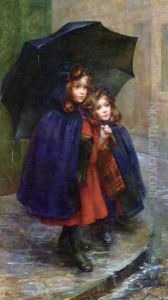Marthe Marie Louise Boyer-Breton Paintings
Marthe Marie Louise Boyer-Breton was a French painter born on April 5, 1865, in Paris. She was active in the late 19th and early 20th centuries, a period that saw significant developments in the art world, including the birth of Impressionism and Post-Impressionism. Boyer-Breton's work, however, remained more aligned with traditional academic standards and the beauty of everyday life, rather than the avant-garde movements of her time.
Marthe Boyer-Breton was known for her domestic scenes, landscapes, and still life paintings. Her style was characterized by a delicate and sensitive approach to light and composition, which was typical of the artists who adhered to the more conservative tendencies of the period. Boyer-Breton received her artistic training at the Académie Julian in Paris, a progressive institution that was one of the first to admit female students. There, she studied under masters such as William-Adolphe Bouguereau and Tony Robert-Fleury, who were well-known for their academic style.
Throughout her career, Marthe Boyer-Breton exhibited her works at various salons and exhibitions, including the prestigious Salon de Paris. Her paintings were well-received, and she gained recognition for her artistic talents. Despite the male-dominated art world of her time, she managed to carve out a space for herself and maintain a successful career as a female artist.
Boyer-Breton's works often depicted serene and intimate moments of family life, reflecting her own values and the societal norms of the time. She painted women and children with warmth and a sense of calm, often infusing her scenes with a gentle nostalgia. These works resonated with audiences who were seeking comfort and familiarity amidst the rapidly changing world of the Industrial Revolution and the societal shifts it brought about.
Marthe Boyer-Breton's dedication to her craft and her ability to capture the spirit of her era through her art made her a respected figure in the artistic community. However, like many women artists of her time, her name became less prominent in the annals of art history, overshadowed by her male contemporaries and the more revolutionary art movements that followed.
Marthe Marie Louise Boyer-Breton passed away on May 25, 1922, in Paris. Though not as widely known today, her work remains an important part of the narrative of women artists in the late 19th and early 20th centuries, and her paintings continue to be appreciated for their beauty and historical value.
